Elevations and Locations -
Torvaldsland
Torvaldsland lies in the north of Gor. Though, those who aspire to the Sardar Mountains being the northern pole would believe Torvaldsland actually lies west. This is an interesting point to consider when looking at the poles of Gor - comparing those as written as compared to those perceptions as mapped by others. In this series I assume up is north.
There is not alot of geography written about Torvaldsland. A few notes did continually surface in my mind while mapping this.
First, Torvaldsberg is 'bent arrow' shaped. You can see that in the map on the right. Secondly, the Axe Glacier is known to be shaped like an 'axe'. I took this to mean the head and not so much the handle. Thirdly, the axe 'spills' into the sea. That meaning - the axe touches the Thassa Sea and literally spills into it.
Fourth, the Pass of Tancred can be seen from the axe and 'slopes' down. Now, this is where it got interesting. Because in the books one must first walk 4 days to the highest point from the north. I took that to mean south-east actually. *S The mapping of the artic I will complete later with the lands to the east of Torvaldsland.
In leaving the Thing-Field I saw, in the distance,
a high, snow-capped mountain, steep, sharp, almost like the blade of a
bent spear. I had seen it at various times, but never so clearly as from
the Thing-Field. I suppose the Thing-Field might, partly, have been selected
for the aspect of this mountain. It was a remarkable peak. "What
mountain is that?" I asked. "It is the Torvaldsberg, said Ivar
Forkbeard. "The Torvaldsberg?" I asked.
In the legends, it is said that Torvald sleeps in the moun-tain, smiled
Ivar Forkbeard, to awaken when, once more, he is needed in Torvaldsland."Marauders
of Gor Pg 180
“This” said the Forkbeard, “is
his chamber.” His voice shook. “Torvald, “ said he, “sleeps
in the Torvaldsberg, and has done so for a thousand years. He waits to
be wakened. When his land needs him, he shall awake. He shall then lead
us in battle. Again he will lead the men of the north”.
Marauders of Gor Pg 232
The Torvaldsberg is, all things considered, an extremely dangerous mountain. Yet it is clearly not unscalable, as I learned, without equipment. It has the shape of a spear blade, broad, which has been bent near the tip. It is something over four and a half pasangs in height, or something over seventeen thousand Earth feet. It is not the highest mountain on Gor but it is one of the most dramatic, and most impressive. It is also, in its fearful way, beautiful. Marauders of Gor Pg 220
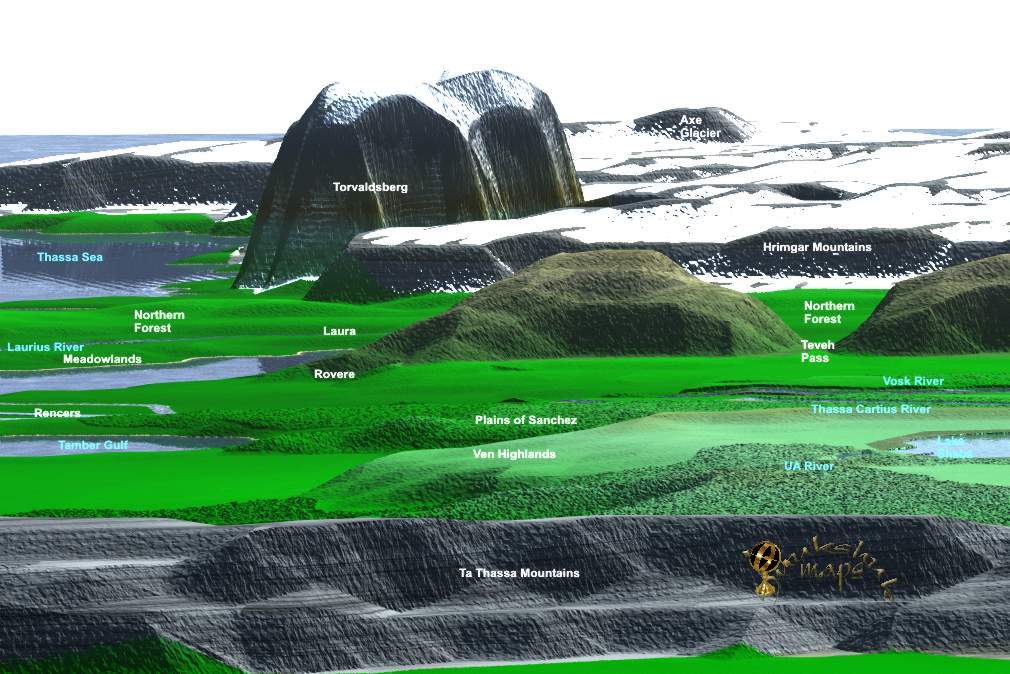
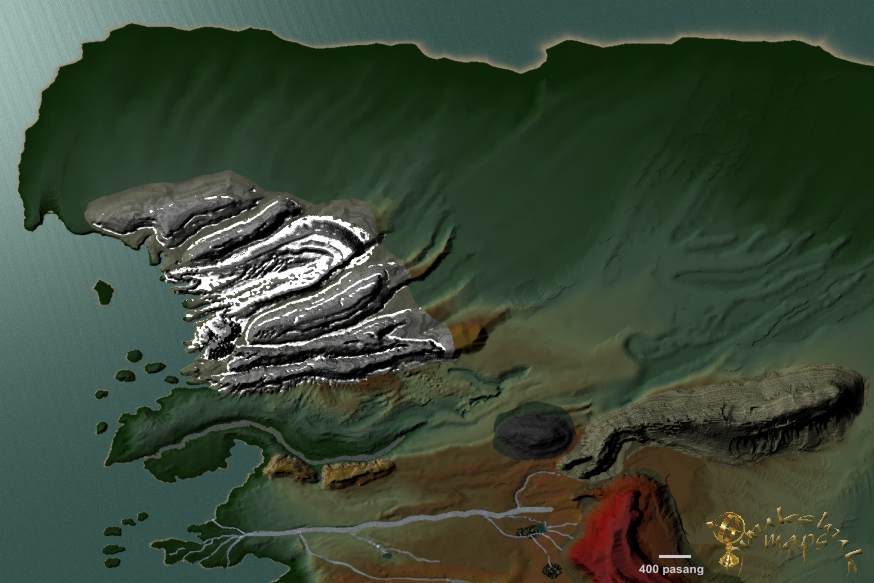
The 'Axe' of the glacier can quickly be seen in the upper image. In the middle of winter most of this land would be covered in snow. These images are summer images, for the purposes of showing landforms. There are several passes in the Hrimgar Mountains.
In the second image the 'bent arrow' shape of Torvaldsberg is readily seen. It was interesting mapping Torvaldsberg, because it rises almost 17,000 feet. How do you make a mountain of that size, that must be majestic and clearly a symbol of the region? That was the question. For that I focused on the the Torvalds' berg' part - in other words it looks much like an iceberg rising from the land. It is striking and has sheer rock cliffs.
Ax Glacier was far to the north, a glacier spilling
between two mountains of stone, taking in its path to the sea, spreading,
the form of an ax. The men of the country of Ax Glacier fish for whales
and hunt snow sleen. They cannot farm that far to the north. Thorgeir,
it so happened, of course, was the only man of the Ax Glacier country,
which is usually taken as the northern border of Torvaldsland, before
the ice belts of Gor's arctic north, who was at the Thing-Fair. Marauders
of Gor Pg 139
"It is a herd of northern tabuk," said Samos, "a gigantic
herd, one of several. The herd of Tancred winters in the rims of the northern
forests south and east of Torvaldsland. In the spring, short-haired and
hungry, they emerge from the forests hind migrate northward." He
indicated the map. "They follow this route," he said, "emerging
from the forest here, skirting Torvaldsland here, to the east, and then
moving west above Torvaldsland, to the sea. They follow the shore of Thassa
north, cross Ax Glacier here, like dark clouds on the ice, then continue
to follow the shore north here, until they then turn eastward into the
tundra of the polar basin, for their summer grazing. With the coming of
winter, long-haired and fat, they return by the same route to the forests.
This migration, like others of its kind, occurs annually." Beasts
of Gor
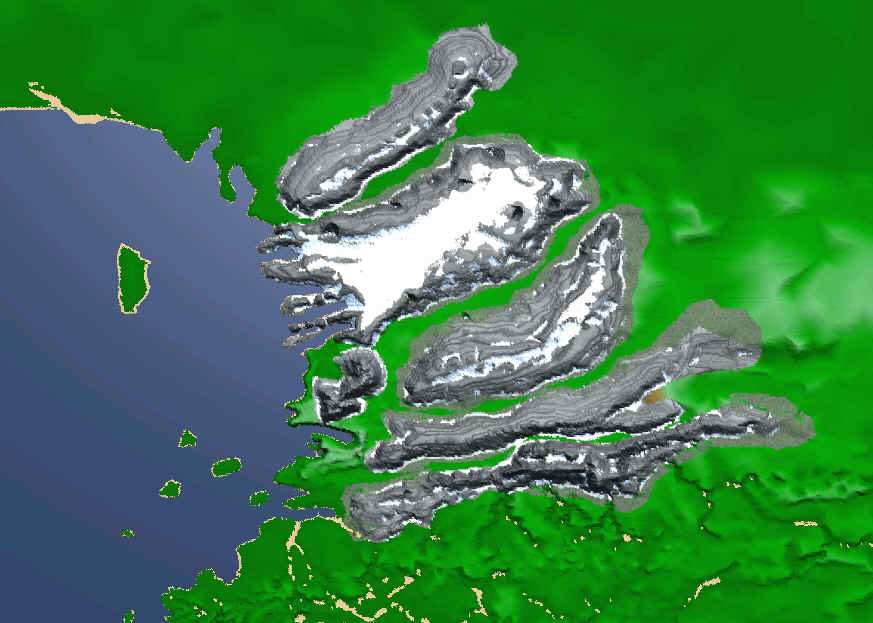
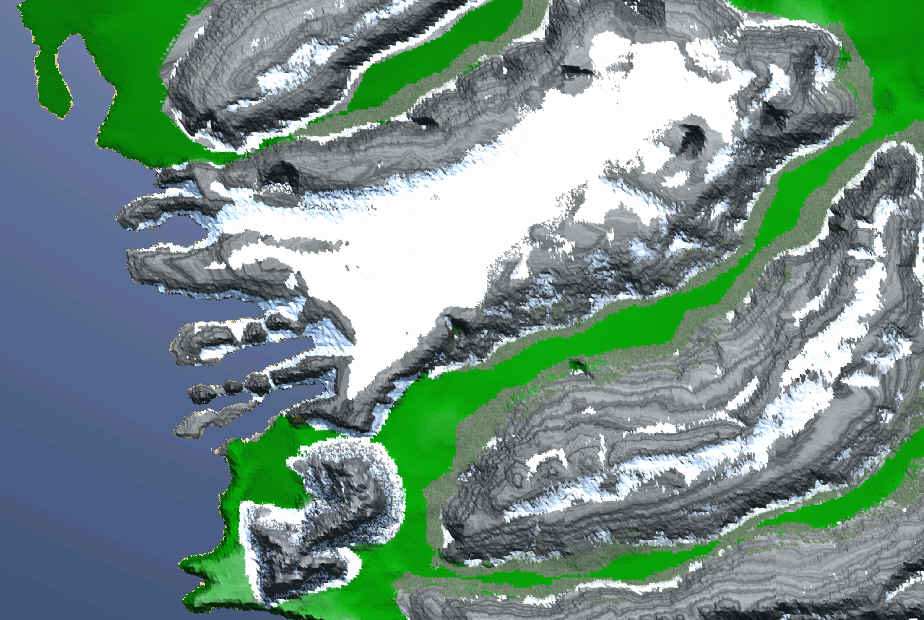
In Torvaldsland there is not much agricultual land. Food is scarce and usually hunted. Because the stream has a moderating effect on the climate, some sa-tarna of a northern variety can be grown. Thus, there are small irregular spaced farms about. They are yellowish in this image near Torvaldsberg.
Torvaldsland is a cruel, harsh, rocky land. It contains many cliffs, inlets and mountains. Its arable soil is thin, and found in patches. The size of the average farm is very small. Good soil is rare and highly prized. Communication between farms is often by sea, in small boats. Without the stream of Torvald, it would probably be impossible to raise cereal crops in sufficient quantity to feed even its relatively sparse population. Marauders of Gor Pg 55
"The waters north of Ax Glacier are ruthless,"
said Samos. "Send it," I said. "Very well," he said.
"There was something else," I said. "It is nothing,"
he said. "Tell me," I said. "Here," he said, moving
a bit, "here." He crouched over the mosaic where it delineated
the sea, an arm of Thassa, crescentlike, extending northward and eastward,
tangent upon the polar shores. The sea in this area was frozen for more
than half the year. Winds and tides broke the ice, crushing and piling
it in fantastic shapes, wild, trackless conformations, the sport of a
terrible nature at play, the dreaded pack ice of the north.
Samos put the lamp down on the floor. "Here," he said, pointing.
"It lies somewhere here."
"What?" I asked. Nothing was indicated on the map.
"The mountain that does not move," he said.
"Most mountains do not move," I smiled.
"The ice mountains of the polar sea," he said, "drift eastward."
"I see," I said. Samos referred to an iceberg. Some of these
are gigantic, pasangs in width, hundreds of feet high. They break from
glaciers, usually in the spring and summer, and drift in Thassa, moving
with the currents. The currents generally moved eastward above the polar
basin. Gorean has no expression specifically for an iceberg. The same
expression is used for both mountain and iceberg. If a reference should
he unclear the expression is qualified, as by saying, "ice mountain."
A mountain is a mountain to Goreans, regardless of whether it be formed
of soil and stone, or ice. We tend to think of mountains as being land
formations. The Gorean tends to think more of them as being objects of
a certain sort, rather than objects of a certain sort with a particular
location. In a sense, English does, too, for the expression ‘berg’
is simple German for ‘mountain’, and the expression ‘iceberg’,
then is a composite word which, literally translated would yield ‘ice
mountain’ or ‘mountain of ice’. ‘Berg’, of course,
in actual German, would be capitalized, for it is a noun. Interestingly,
Goreans, although they do not capitalize all nouns do capitalize many
more of them than would be capitalized in, say, English or French. Sometimes
context determines capitalization. Languages are diverse and interesting,
idiosyncratic and fascinating. I will generally use the expression ‘iceberg’
for it is easier for me to do so. "There is here an iceberg,"
said Samos, pointing to the map, "which is not following the parsit
current." Samos had said, literally, of course, ‘ice mountain’.
The parsit current is the main eastward current above the polar basin.
It is called the parsit current for it is followed by several varieties
of migrating parsit, a small, narrow, usually striped fish. Sleen, interestingly,
come northward with the parsit. their own migrations synchronized with
those of the parsit, which forms for them their principal prey. The four
main types of sea sleen found in the polar seas are the black sleen, the
brown sleen, the tusked sleen and the flat-nosed sleen. There is a time
of year for the arrival of each, depending on the waves of the parsit
migrations. Not all members of a species of sleen migrate. Also, some
winter under the ice, remaining generally dormant, rising every quarter
of an Ahn or so to breathe. This is done at breaks in the ice or at gnawed
breathing holes. "An iceberg which does not drift with the current,
which does not move with its brothers," I said. "Yes,"
said Samos.
Beasts of Gor

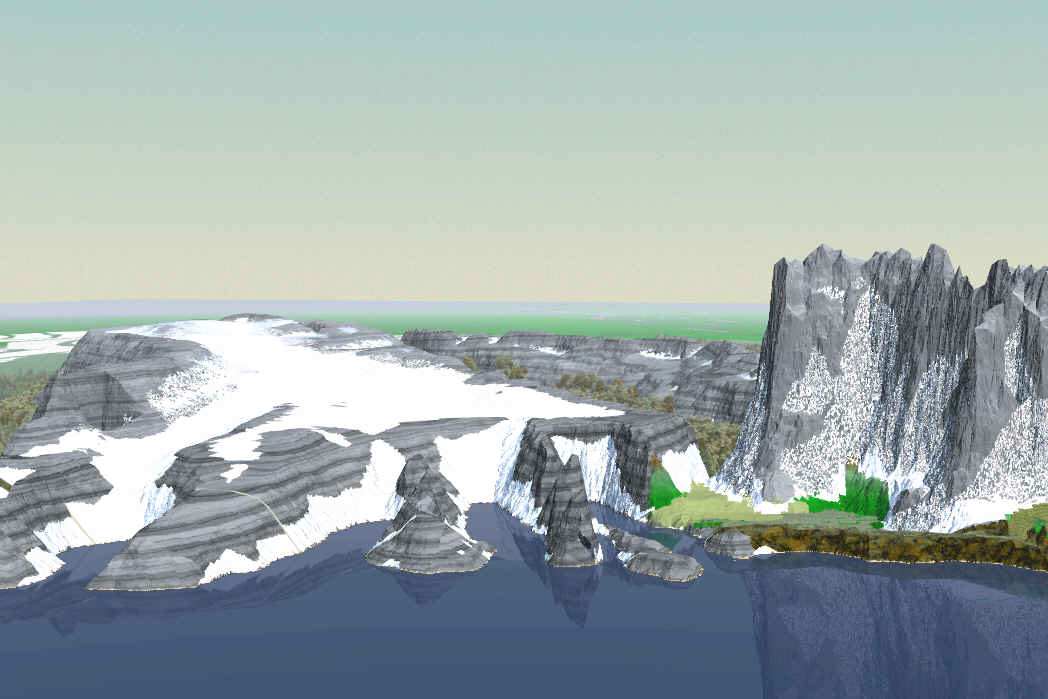
Four days after leaving the northern edge of Ax Glacier, we climbed to the height of the pass of Tancred, the mountains of the Hrimgar flanking us on either side. Below the height, the pass sloping downward, we could see the tundra of the polar plain. It is thousands of pasangs in width, and hundreds in depth; it extends, beyond horizons we could see, to the southern edge of the northern, or polar, sea. Beasts of Gor Pg 192
"It must be difficult to place the logs
of the wall," I said, "because of the permafrost." "How
difficult you will learn," she said. She was still angry that her
authority had been flouted in my presence.
At this latitude, even in the summer, the earth only thaws to a depth
of some two feet. Beneath this depth one strikes still frozen ground.
it is almost like stone. Picks and drive bars ring upon it.
Beasts of Gor
"What ship is this?" asked Imnak.
"I had a ship sent north," said I, "with food for the men
of the polar basin, when I heard the herd of Tancred had not yet trod
the snows of Ax Glacier."
Beasts of Gor
I could see the blue line of the Hrimgar Mountains
in the distance to the south. To the north the tundra stretched forth
to the horizoll. Many people do not understand the nature of the polar
north. For one thing, it is very dry. Less snow falls there generally
than falls in most lower latitudes. Snow that does fall, of course, is
less likely to melt. Most of the land is tundra, a cool, generally level
or slightly wavy, treeless plain. In the summer this tundra, covered with
mosses, shrubs and lichens, because of the melted surface ice and the
permafrost beneath, preventing complete drainage, is soft and spongy.
In the winter, of course, and in the early spring and late fall, desolate,
bleak and frozen, wind-swept, it presents the aspect of a barren, alien
landscape. At such times the red hunters will dwell by the sea, in the
spring and fall by its shores, and, in the winter, going out on the ice
itself.
Beasts of Gor
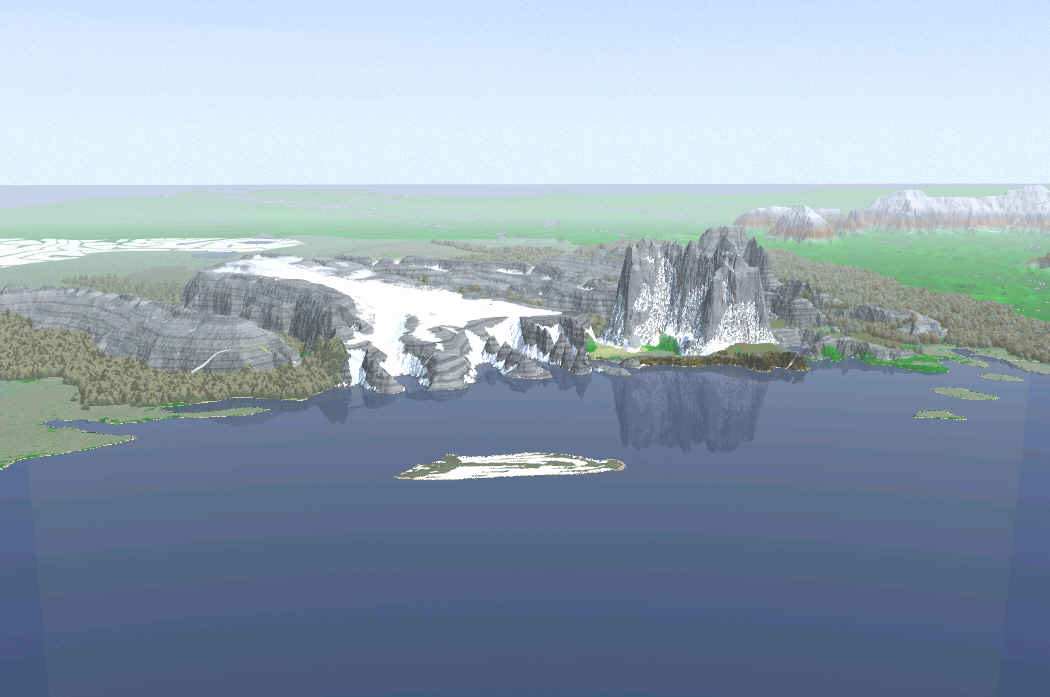
In the second image you can see the nothern edges of the Northern Forest. The forested areas above that line, into Torvaldsland, are much thinner and less frequent.
The Hrimgar Mountains are said to be tiered. I looked at quite a few maps before deciding the tiers run north-east to coincide with the glaciers like the axe. Afterall, it is the glaciers that create the morraines or mountains when the water melts.
Kassau is the seat of the High Initiate of the north, who claims spiritual sovereignty over Torvaldsland, which is commonly taken to commence with the thinning of the trees northward. Marauders of Gor Pg 25
The stream of Torvald is a current, as a broad river in the sea, pasangs wide, whose temperature is greater than that of the surrounding water. Without it, much of Torvaldsland, bleak as it is, would only be a frozen waste. Torvaldsland is a cruel, harsh, rocky land. It contains many cliffs, inlets and mountains. Its arable soil is thin, and found in patches. The size of the average farm is very small. Good soil is rare and highly prized. Communication between farms is often by sea, in small boats. Without the stream of Torvald, it would probably be impossible to raise cereal crops in sufficient quantity to feed even its relatively sparse population. There is often not enough food under any conditions, particularly in northern Torvaldsland, and famine is not unknown. In such cases men feed on bark, and lichens, and seaweed. It is not strange that the young men of Torvaldsland often look to the sea, and beyond it, for their fortunes. The stream of Torvald is regarded by the men of Torvaldsland as a gift of Thor, bestowed upon Torvald, the legendary founder and hero of the land, in exchange for a ring of gold. Marauders of Gor Pg. 55, 45
The tundra at this time of year belies its reputation
for bleakness. In many places it bursts into bloom with small flowers.
Almost all of the plants of this nature are perennials, as the growing
season is too short to permit most annuals to complete their growing cycle.
In the winter buds of many of these plants lie dormant in a fluffy sheath
which protects them from cold. Some two hundred and forty different types
of plants grow in the Gorean arctic within five hundred pasangs of the
pole. None of these, interestingly, is poisonous, and none possesses thorns.
During the summer plants and flowers will grow almost anywhere in the
arctic except on or near the glacial ice. At certain times in the summer
even insects will appear, black, long-winged flies, in great swarms, coating
the sides of tents and the faces of men.
Beasts of Gor

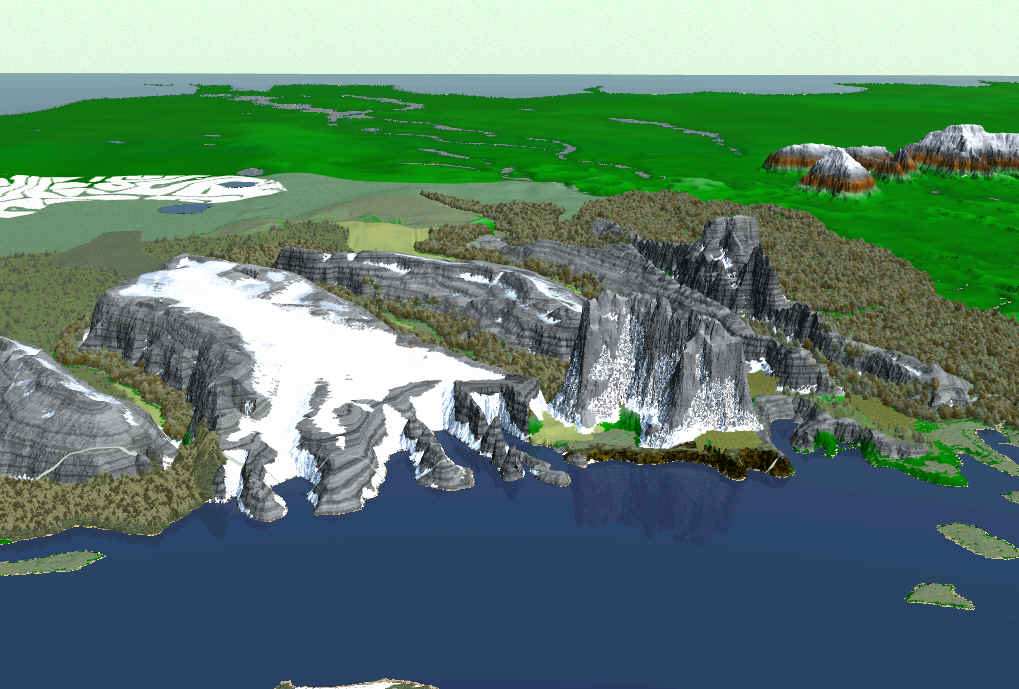
The Pass of Tancred is a stretch of land between the Hrimgar Mountains. Firstly though, when I consider the Hrimgar I think of the range as the Hrimgar, not just one mountain. All of these mountains are the Hrimgar with the exception of the Torvaldsberg. The reason for saying this simple. The glaciers have melted the mountain over time. It remains one mountain with numerous high tiered passes. One of which is the Pass of Tancred upon which animals of the far north migrate to.
Kassau is a town of wood, and the temple is the greatest building in the town, It towers far above the squalid huts, and stabler homes of merchants, which crowd about it. Too, the town is surrounded by a wall, with two gates, one large, facing the inlet, leading in from Thassa, the other small, leading to the forest behind the town. The wall is of sharpened logs, and is defended by a catwalk. Marauders of Gor Pg 27
The population of Kassau I did not think to be more than eleven hundred persons. There are villages about, however, which use Kassau as their market and meeting place. If we count these perhaps we might think of greater Kassau as having a population in the neighbourhood of some twenty-three hundred persons. Marauders of Gor Pg 28
Trade to the south, of course is largely in
furs acquired from Torvaldsland, and in barrels of smoked, dried parsit
fish. From the south, of course, the people of Kassau obtain the goods
they trade northward to Torvaldsland and , too, of course, civilised goods
for themselves.
Marauders of Gor Pg 28
The main business of Kassau is trade, lumber
and fishing. The slender striped parsit fish has vast plankton banks north
of the town, and may there, particularly in the spring and the fall, be
taken in great numbers. The smell of the fish-drying sheds of Kassau carries
far out to sea. The trade is largely in furs from the north, exchanged
for weapons, iron bars, salt and luxury goods, such as jewellery and silk,
from the south, usually brought to Kassau from Lydius by ten-oared coasting
vessel. Lumber, of course, is a valuable commodity. It is generally milled
and taken northward. Torvaldsland, though not treeless, is bleak. In it,
fine Ka-la-na wood, for example, and supple temwood, cannot grow. These
two woods are prized in the north.
Marauders of Gor Pg 27
The most important thing about Kassau, however,
was that it was the seat of the High Initiate of the north. It was, accordingly,
the spiritual centre of a district extending for hundreds of pasangs around.
The nearest High Initiate to Kassau was hundreds of pasangs south in Lydius.
Marauders of Gor Pg 28


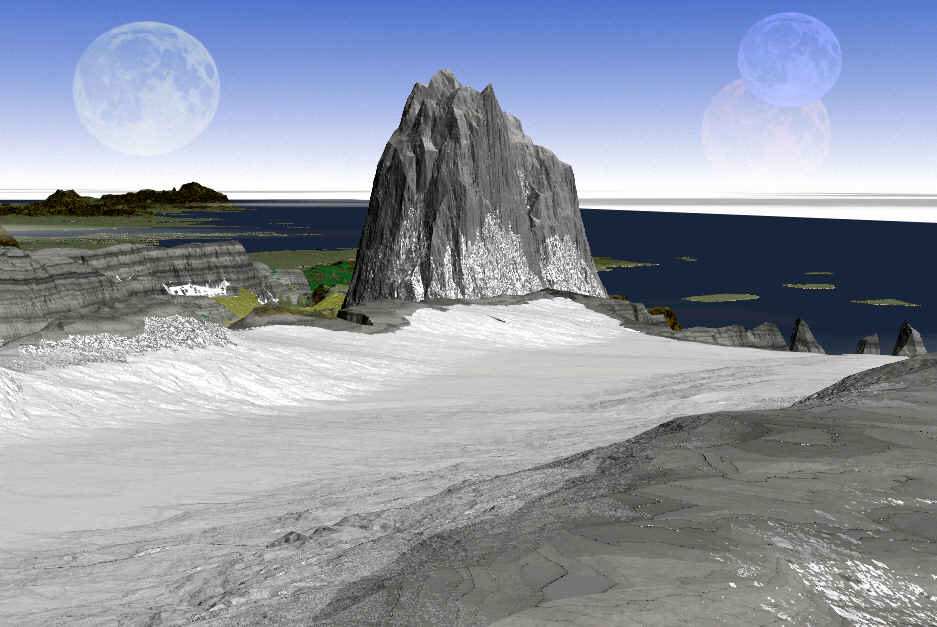
.. an island in Thassa, it is located West of
bleak, rocky Torvaldsland and north of the northern forests.( Skjern )
Captive of Gor Pg 198
the 4 free ports maintained on the Thassa north and south of the gorean
equator are Lydius, Helmutsport, Schend,i and Bazi.
Raiders of Gor Pg 137
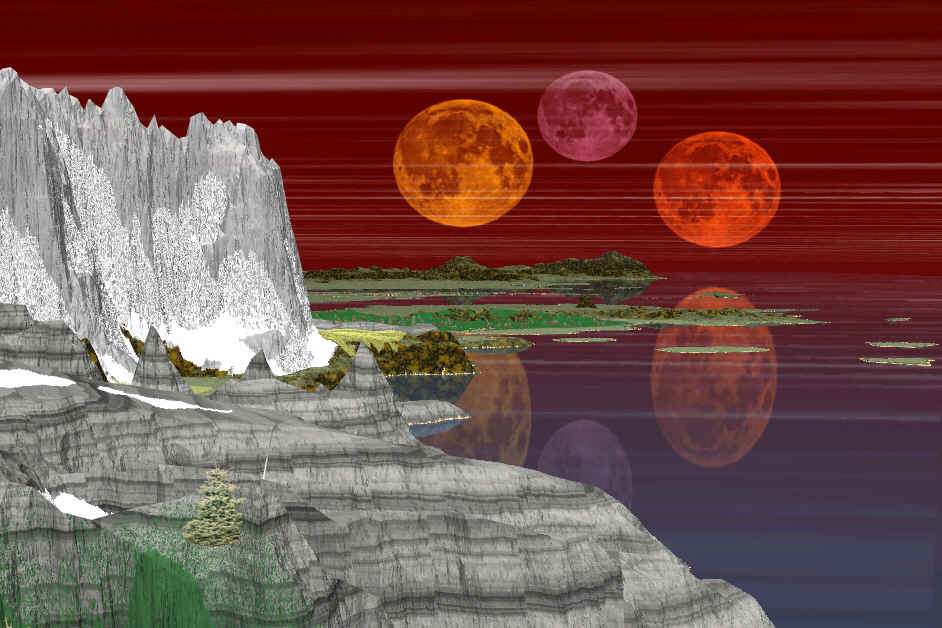
The men of Torvaldsland sometimes guide their vessels by noting the directions of the waves, breaking against the prow, these correlated with prevailing winds. Sometimes they use the shadows of the gunwales, falling across the thwarts, judging their angles. The sun, too, is used, and, at night, the stars give them suitable compass, even in the open sea. It is a matter of tradition not to rely on the needle compass, as is done in the south. The Gorean compass points to the Sardar, the home of the Priest-Kings. The men of Torvaldsland do not use it. They do not need it. The sextant, however, correlated with sun and stars, is not unknown to them. It is commonly relied upon, however, only in unfamiliar waters. Even fog banks, and the feeding grounds of whales, and ice floes, in given seasons, in their waters, give the men of Torvaldsland information as to their whereabouts, they utilizing such things as easily, as unconsciously, as a peasant might a mountain, or a hunter a river. Marauders of Gor Pg 56
The ships of the men of Torvaldsland are swift. In a day, a full Gorean day of twenty Ahn, with a fair wind they can cover from two hundred to two hundred and fifty pasangs. There had been much fear in Kassau when the ship of Ivar Forkbeard had entered the inlet. But it had come at midday. And on its mast, wound and painted and of painted wood, had hung the white shield. His men had rowed slowly, singing a dirge at the oars. Even the tarnhead at the ship’s prow had been swung back on the great wooden hinges. Sometimes, in light galleys, it is so attached, to remove its weight from the prow’s height, to ensure greater stability in high seas; it is always, however, at the prow in harbor, or when the ship inters an inlet or river to make its strike; in calm seas of course, there is little or no danger in permitting it to surmount the prow generally. that the tarnhead was hinged back, as the ship entered the inlet, was suitable indication like the white shield, that it came in peace. Marauders of Gor Pg 56
There are tiers of mountains, interlaced chains
of them, both east of Torvaldaland and north of her. Ax Glacier lies in
one valley between two of these chains. These chains, together, are sometimes
called the Hrimgar Mountains, which, in Gorean, means the Barrier Mountains.
They are surely not a barrier, however, in the sense that the Voltai Mountains,
or even the Thentis Mountains or Ta-Thassa Mountains, are barriers. The
Hrimgar Mountains are not as rugged or formidable as any of these chains,
and they are penetrated by numerous passes. One such pass, through which
we trekked, is called the pass of Tancred, because it is the pass used
annually by the migration of the herd of Tancred.
Beasts of Gor
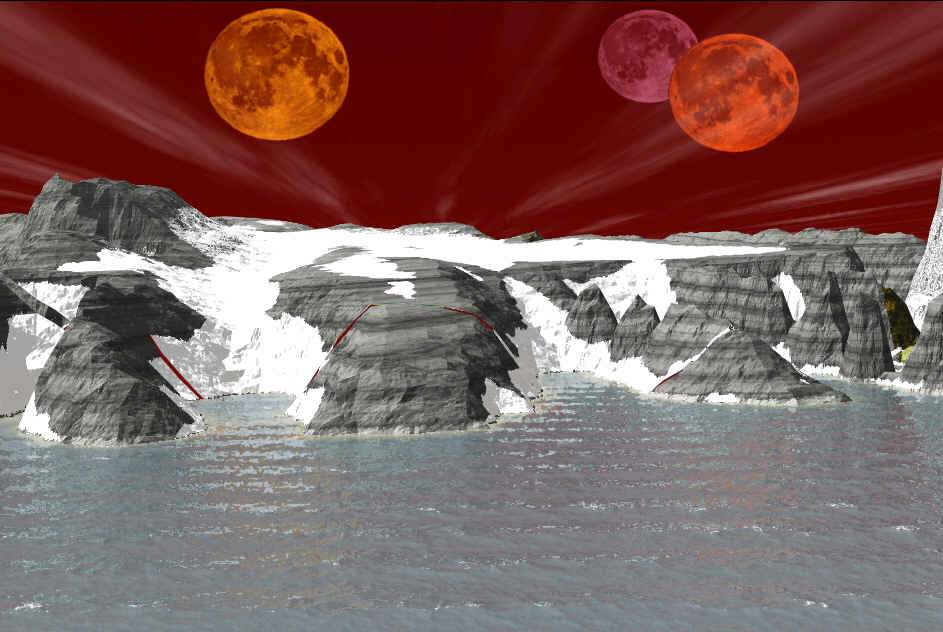
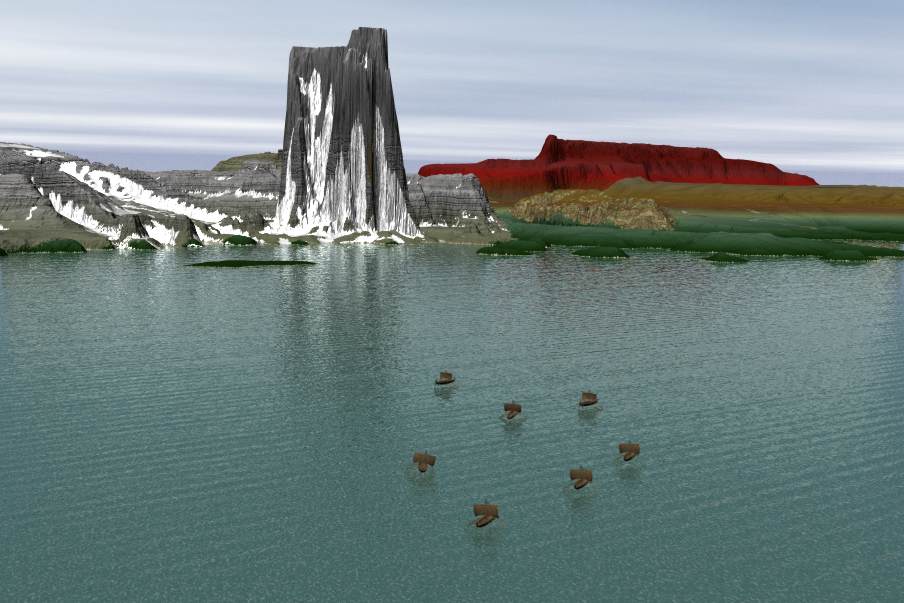
It took ten days to cross Ax Glacier. There
are many glacial lines among the rocks and mountains of the north, but
Ax Glacier is easily the broadest and most famous. These glaciers, like
frozen rivers or lakes of ice, or emptying seas, depend to the shores
of Thassa, seeking her, flowing some few feet a year, imperceptibly like
stone, to her chill waters. More than once we heard gigantic crashes as
hundreds of feet or more of ice broke away from the glacial edge and tumbled
roaring into the sea. It is thus, of course, that icebergs are formed.
These great pieces and mountains of ice, shattering from the brinks of
Ax Glacier and her smaller sisters, in time, drifting, carried by currents,
would reach the northern sea, that eastward-reaching extension of Thassa
rimming the polar basin. It was in that northern, or polar, sea that there
was said to exist, if it were not myth or invention, the "mountain
that did not move," that iceberg which, in defiance of tide, wind
and current, stood immobilely fixed. Sometimes we could see, from where
we stood, the sea, with these great pieces of ice within it. Some of these
pieces of ice reared more than a thousand feet into the air. Sometimes
they are even miles long. Their occasional vastnesses, and the might of
the forces that have formed them, become even more impressive when it
is understood that what one can see above the surface does little more
than hint at what lies below. The fresh-water ice from which such blocks
are formed is less dense than the salt water in which they float, weighing
only about seven eighths as much. Thus, in a given piece of such ice,
there is some seven times more beneath the surface than appears visible
above it. These pieces of ice, like moving, drifting reefs, can be hazardous
to shipping. The smaller ones, especially at night, can be particularly
dangerous. Gorean ships, however, seldom run afoul of them. They are,
generally, very shallow-drafted, which permits them to come much closer
to such ice without the danger that would threaten deeper-keeled craft;
too, the Gorean ship, because of the shallow draft, can occasionally run
up on such ice, sliding onto it, rather than breaking apart when it strikes
it; too, the Gorean vessel, because it is usually light in weight, tends
to be extremely responsive to its helm or helms, this permitting such
obstacles to be avoided on shorter notice than would be possible with
a heavier more sluggish vessel; too, Gorean vessels, except when manned
by those of Torvaldsland and the northern islands, usually beach at night;
thus, when visibility is poor, they are not abroad; if they do not beach
they will sometimes lower their masts and yards and throw over their anchors;
that most Gorean ships are oared vessels, too, gives the crewmen recourse
in an emergency; they are not at the mercy of the wind and they can, if
necessary, back the ship off the ice; lastly, few Gorean ships ply the
northern waters in the months of darkness; sufficiently far north, of
course, the sea freezes in the winter. A much greater danger to Gorean
shipping than the iceberg is the sea itself, when it begins to freeze.
A ship caught in the ice, if not constantly cut and chopped free, its
men on the ice itself, can become solidly frozen, arrested, in the ice;
then it is at the mercy of pressures and bucklings; the ice, grinding,
shifting, can shatter a ship, breaking it apart like a lacing of frozen,
brittle twigs.
Beasts of Gor
My thanks to 'autumn NS' for her help in this as well as Karnik, ARES, riella 'X' and ka'reena (AoA)..
Individual artwork by ka'reena is copyright.
All maps and images by Inukshuk may be freely used with acknowledgement.
Right click 'Save' for the larger images.
Inukshuk - Sep 4, 2002
